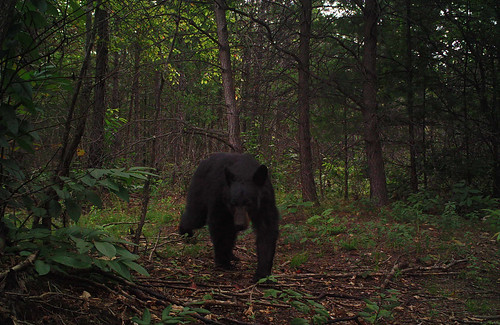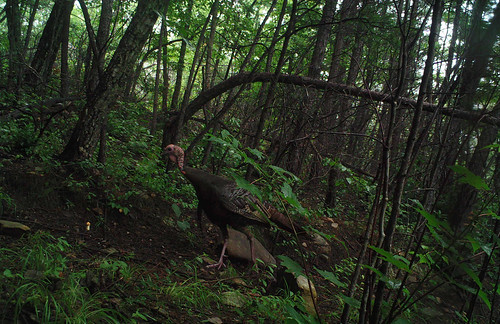
Wildlife cameras capture a young black bear enjoying new growth from a prescribed burn on the Pisgah National Forest. Photo credit: Lisa Jennings
It was my first prescribed burn. After weeks of training and months of anticipation, I was finally on the ground – drip torch in hand – ready to apply fire to restore the mixed pine-hardwood forests at the edge of the Blue Ridge Mountains on the Pisgah National Forest.
Joining the U.S Forest Service only two months earlier, my knowledge of fire’s effect on plant and wildlife communities was limited. But as the coordinator for the Grandfather Restoration Project, part of the Collaborative Forest Landscape Restoration program, I had to quickly come up to speed with the on-the-ground reality of prescribed fire use.
As I lit my drip torch that early March morning, igniting the thick leaf litter and dense shrubs that had accumulated during years of fire suppression, I couldn’t help but wonder – What happens to the wildlife after the fire?
Utilizing fire is unnerving to those not familiar with fire as a restoration tool. The reality is much different; just as certain plants need fire to succeed, the animals that depend on those species benefit from fire as well.
With the evolving use of prescribed fire as a restoration tool, it is critical to study the effects of fire on the communities we seek to restore. Traditional fire studies often focus on vegetation. The participants in the Grandfather Restoration Project decided to take it one step further and directly study wildlife use in sites treated with prescribed fire compared with untreated sites.
Working collaboratively, wildlife specialists from Pisgah National Forest, the North Carolina Wildlife Resource Commission, and The Nature Conservancy designed a cutting-edge study using wildlife cameras.
Re-entering the prescribed burn unit just four months after the fire, wildlife cameras in tow, I could see the changes in vegetation. Arising from the blackened ground a lush herbaceous layer had appeared, carpeting the forest with blueberries and grasses. Using 50 camera points over a six-week period in July and August, we studied the wildlife species that use our forests, and what habitats they prefer.
Almost immediately, our cameras captured images of white-tailed deer, black bear, turkey and other wildlife attracted to the abundant grasses and forbs. Not only was I encouraged from the positive wildlife response to our burn, but our data indicated a higher usage of the burned unit by wildlife when compared to the unburned unit; valuable information for land managers in determining population estimates and predator-prey ratios.
I often think back to that first prescribed burn. I now understand what wildlife have known all along; that not only are wildlife capable of surviving fire, they reap the rewards of new growth, cover, and food stemming from fire and prescribed burning. For me, seeing these benefits firsthand is one of the most rewarding parts of my job with the U.S. Forest Service.

Wild turkeys often nest in recently burned areas, taking full advantage of newly established sources of food and cover. Photo credit: Lisa Jennings
No comments:
Post a Comment
Note: Only a member of this blog may post a comment.